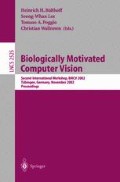Abstract
Gaze detection is to locate the position on a monitor screen where a user is looking. In our work, we implement it with a computer vision systemsetting a IR-LED based single camera. To detect the gaze position, we locate facial features, which is effectively performed with IR-LED based camera and SVM(Support Vector Machine). When a user gazes at a position of monitor, we can compute the 3D positions of those features based on 3D rotation and translation estimation and affine transform. Finally, the gaze position by the facial movements is computed from the normal vector of the plane determined by those computed 3D positions of features. In addition, we use a trained neural network to detect the gaze position by eye’s movement. As experimental results, we can obtain the facial and eye gaze position on a monitor and the gaze position accuracy between the computed positions and the real ones is about 4.8 cmof RMS error.
Access this chapter
Tax calculation will be finalised at checkout
Purchases are for personal use only
Preview
Unable to display preview. Download preview PDF.
References
A. Azarbayejani., 1993. Visually Controlled Graphics. IEEE Trans. PAMI, Vol. 15, No. 6, pp. 602–605
K. R. Park et al., Gaze Point Detection by Computing the 3D Positions and 3D Motions of Face, IEICE Trans. Inf.&Syst.,Vol. E.83-D, No.4, pp.884–894, Apr 2000 (http://search.ieice.org/2000/pdf/e83-d-4-884.pdf)
K. R. Park et al., Gaze Detection by Estimating the Depth and 3D Motions of Facial Features in Monocular Images, IEICE Trans. Fundamentals, Vol. E.82-A, No. 10, pp. 2274–2284, Oct 1999
K. OHMURA et al., 1989. Pointing Operation Using Detection of Face Direction froma Single View. IEICE Trans. Inf.&Syst., Vol. J72-D-II, No.9, pp. 1441–1447
P. Ballard et al., 1995. Controlling a Computer via Facial Aspect. IEEE Trans. on SMC, Vol. 25, No. 4, pp. 669–677
A. Gee et al., 1996. Fast visual tracking by temporal consensus, Image and Vision Computing. Vol. 14, pp. 105–114
J. Heinzmann et al., 1998. 3D Facial Pose and Gaze Point Estimation using a Robust Real-Time Tracking Paradigm. Proceedings of ICAFGR, pp. 142–147
T. Rikert et al., 1998. Gaze Estimation using Morphable Models. Proc. of ICAFGR, pp. 436–441
A. Ali-A-L et al., Man-machine interface through eyeball direction of gaze. Proc. of the Southeastern Symposiumon SystemTheory 1997, pp. 478–82
A. TOMONO et al., 1994. Eye Tracking Method Using an Image Pickup Apparatus. European Patent Specification-94101635
Seika-Tenkai-Tokushuu-Go, ATR Journal, 1996
Porrill-J et al., Robust and optimal use of information in stereo vision. Nature. vol. 397, no. 6714, Jan. 1999, pp. 63–6
Varchmin-AC et al., image based recognition of gaze direction using adaptive methods. Gesture and Sign Language in Human-Computer Interaction. Int. Gesture Workshop Proc. Berlin, Germany, 1998, pp. 245–57.
J. Heinzmann et al., 1997. Robust real-time face tracking and gesture recognition. Proc. of the IJCAI, Vol. 2, pp. 1525–1530
Matsumoto-Y, et al., An algorithm for real-time stereo vision implementation of head pose and gaze direction measurement. Proc. the ICAFGR 2000. pp. 499–504
Newman-R et al., Real-time stereo tracking for head pose and gaze estimation. Proceedings the 4th ICAFGR 2000. pp. 122–8
Betke-M et al., Gaze detection via self-organizing gray-scale units. Proc. Int.Workshop on Recognition, Analysis, and Tracking of Faces and Gestures in Real-Time System1999. pp. 70–6
K. R. Park et al., 2000. Intelligent Process Control via Gaze Detection Technology. EAAI, Vol. 13, No. 5, pp. 577–587
T. BROIDA et al., 1990. Recursive 3-D Motion Estimation from a Monocular Image Sequence. IEEE Trans. Aerospace and Electronic Systems, Vol. 26, No. 4, pp. 639–656
T. Fukuhara et al., 1993. 3D-motion estimation of human head for model-based image coding. IEE Proc., Vol. 140, No. 1, pp. 26–35
Author information
Authors and Affiliations
Editor information
Editors and Affiliations
Rights and permissions
Copyright information
© 2002 Springer-Verlag Berlin Heidelberg
About this paper
Cite this paper
Park, K.R., Lee, J.J., Kim, J. (2002). Facial and Eye Gaze Detection. In: Bülthoff, H.H., Wallraven, C., Lee, SW., Poggio, T.A. (eds) Biologically Motivated Computer Vision. BMCV 2002. Lecture Notes in Computer Science, vol 2525. Springer, Berlin, Heidelberg. https://doi.org/10.1007/3-540-36181-2_37
Download citation
DOI: https://doi.org/10.1007/3-540-36181-2_37
Published:
Publisher Name: Springer, Berlin, Heidelberg
Print ISBN: 978-3-540-00174-4
Online ISBN: 978-3-540-36181-7
eBook Packages: Springer Book Archive

